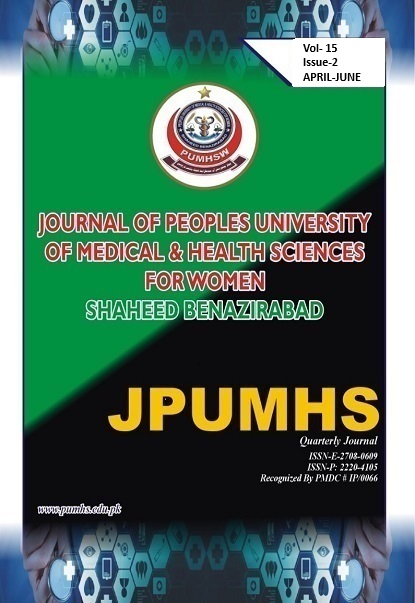VISUAL HEALTH IN CHILDREN: PREVALENCE AND TYPES OF REFRACTIVE ERRORS IN SCHOOL GOING CHILDREN’S.
J Peop Univ Med Health Sci. 2025:15(2), 175-180. http://doi.org/10.46536/jpumhs/2025/15.02.638
Keywords:
refractive error, school going, children, spectacle, risk factors.Abstract
BACKGROUND: Refractive errors are the most frequent cause of vision impairment in school-age children globally. Uncorrected refractive defects have long-term detrimental impacts on visual health, social integration, and academic achievement. Preventing needless morbidity requires early diagnosis and treatment. In many low-middle-income nations, including Pakistan, routine vision screening for school-age children is urgently needed, and there is little to no recent local data on the prevalence of
refractive errors. OBJECTIVE: To determine the prevalence and types of refractive errors among school-going children and identify associated risk factors. METHODS: This cross-sectional study was performed at the Ophthalmology Department of Hayatabad Medical Complex, Peshawar,
between July 2023 and June 2024. Total 1198 children aged 5-16 years were chosen from public and private schools by stratified random sampling. Snellen charts were used for visual acuity assessment, pinhole was performed and cycloplegic refraction was also tested. Age, gender, screen time, outdoor activity and spectacle use were documented. RESULTS: Mean age was 10.4 ± 2.9 years, with a male predominance 53.3%, the prevalence of refractive errors was 32.9%. The most prevalent refractive error was myopia (18.6%), astigmatism (10.0%), and hyperopia (4.3%). Refractive error was bilateral in 76.8% of the affected children. Prior to the study only 40.6% had worn spectacles despite having refractive errors, of whom only 39.3% were wearing spectacles regularly. CONCLUSION: This study reported a high burden of refractive error in school-going children of Peshawar, with a low rate of spectacle usage and compliance. Older age, more screen time, and urban residence were major risk factors.
Downloads
Downloads
Published
How to Cite
Issue
Section
License

This work is licensed under a Creative Commons Attribution-NoDerivatives 4.0 International License.




